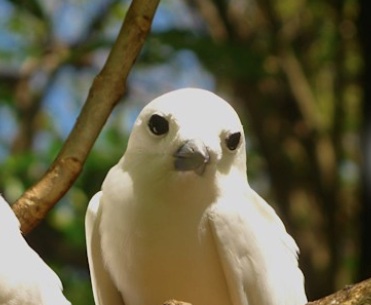You wouldn’t believe what I found outside one of my beautiful listings at the foot of Diamond Head: a nest of Fairy Terns! I was so tickled to see nature in action, and I decided I didn’t know enough about these fascinating birds so I did some research. I have distilled some of my newfound knowledge below so that you will finish the day wiser and more aware of these magnificent little creatures.

Ancient Hawaiian seafarers used the Hawaiian fairy tern, or Manu-o-ku, as an indication that land was close: the bird generally flies out to sea in the morning and then back to land in the evening, so its presence suggested that land was not far off. As nightfall came, the navigators followed the birds until land was sighted.
Today, the Hawaiian fairy tern is found primarily in the Northwest Hawaiian Islands. Amazingly, Oahu is the only main island on which fairy terns reside – and in fact, they only nest in Leeward Oahu, from Niu Valley to Sand Island. Incidentally, this makes Honolulu the only city in the world where the Hawaiian Manu-o-ku is found!
Hawaiian fairy terns haven’t always been found in Honolulu, though. In fact, the first nesting pair wasn’t discovered on Oahu (on Koko Head, specifically) until 1961, and the fairy tern population only numbered about 700 birds in 2003. Today, though, that number has quadrupled – Oahu is now home to about 2,800 nesting birds, where they can be seen roosting in large trees in parks and along the street.
The fairy tern is a medium-sized, all-white seabird that nests in large trees in or near the shore, where they will have easy access to the ocean. Unlike its South Pacific fairy tern cousins in Australia and New Zealand, the Hawaiian fairy tern is completely white, except for a black ring on it eye, a black beak, and pale blue legs and feet. Their tail is subtly forked, and their wingspan is nearly 3 feet long and narrow, which allows them to expend little energy while flying long distances over the ocean. Male and female terns look identical, and their plumage stays the same throughout the year. Fairy tern chicks are usually a bit more mottled in color, with brown or gray feathers mixed into their plumage. By the time they reach breeding age, though, the tern’s plumage has turned completely white.

Manu-o-ku forage in inshore and offshore waters, and consist on a diet primarily of fish and squid. They are opportunistic feeders, and wait on other predators to drive small fish to the surface where they either grab the fish from below the surface or from midair as the fish jumps to escape another predator. When the fairy tern nests, it will bring fish back to its young – you can sometimes see the bird carrying fish in its beak!
One might think that an urban-dwelling bird would struggle to thrive in a big city, where tree trimming and urban development might harm their habitat. But that’s exactly why they thrive, and incidentally what makes these birds so fascinating: when a tree branch is cut a scar or depression is often formed, in which the tern will lay its egg – without a nest! And when the chick is born, it learns very quickly to hold on tight with its teeny little talons so as to avoid being blown off the branch by a gust of wind.
As the chick grows, both the male and female tern participate in feeding and raising the chick until it departs the nest – or rather, the branch – on which it hatched. Often, breeding pairs of terns will return to the same nesting site multiple times to hatch new tern chicks.
In 2007, Mayor Mufi Hanneman designated the Manu-o-ku as the official bird of the City and County of Honolulu. Although the bird is still considered a threatened species, it is certainly making a resurgence, and thanks to many conservation efforts the numbers of fairy tern nesting sites is growing steadily throughout Honolulu. These little creatures are so beautiful and elegant, and I was so blessed to watch them in their natural habitat. If you see one flying around, consider yourself lucky: the Manu-o-ku is one of the only native Hawaiian birds that can be seen in the city of Honolulu!
*Image by 12019 on Pixabay

 Facebook
Facebook
 X
X
 Pinterest
Pinterest
 Copy Link
Copy Link


